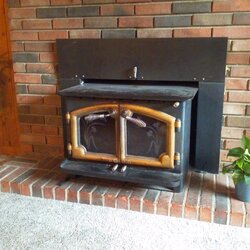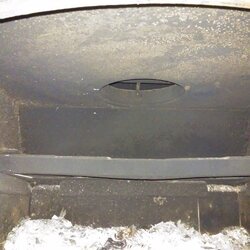First time post here, looking for a little insight.
I bought this "tank" back in 1999 for the sole purpose of having heat when the lights went out on January 1 of 2000 LOL. This Lopi is 26" deep by 23" wide by 17" high and those measurements are with all the firebrick in place. I can't gauge the steel but do believe it's no less and 1/4 in thick all around and weighs a whopping 750 pounds "without" the fire brick. It has two solid brass doors with glass in the center. I've never had the blower but it has a spot for the blower on the bottom with full length vents on the top and the sides, two lower inlet vents to stoke fire on the bottom and one at the top for a glass wash which never worked so my glass is always black unless I run a razor over it.
This is an insert that fits perfectly in my natural fireplace and there is no metal venting, it just vents perfectly out of the chimney itself. With the use of a chimney cap/screen it really eliminates any sparks that go up the flue, but once I get the fire stoking I will shut the flue on the burner down completely, which by design will leave approx. 20% of the opening open and it works very well. Once fired at full throttle, I'll load it up with an assortment of hardwood and close it down except for a smidgent of air inlet at the bottom which will last on average 9 to 10 hours. In a cold Michigan January I'll do this, with a couple of fans blowing and the furnace fan on, I can heat my house quite quickly to an uncomfortable level, which is sometimes nice because opening the windows in January to cool down and get fresh air is pretty nice.
I called Lopi corporate in CA a few years back and their insight was that the unit was a 1983 model (rarely used before I bought it) and the company that manufactured it for them was based in Kalkaska MI and was "fired" because they did not make the units to their specifications (I really believe they made them better)
With this being said, maybe you can assist with some insight.
This unit is really not that efficient, but once going at full throttle it's not bad just not great. There are absolutely no air leaks of any kind but because I go through so much wood I'm considering upgrading to a more efficient unit. Mainly because I don't need to feel like I'm in a sauna so much and I'd like to control the burn a bit better. Would it be feasable to buy a new unit that stokes out with less wood? Are newer units really any good compared to my old tank? Knowing that you cannot buy another like it I don't want to get rid of it but am thinking it may be best to replace it with a more efficient unit. I'm a saver so looking at prices of $5,000 to $8,000 for a new unit is lunacy to me. Also, how old can a unit be and still be safe?
Any insight is appreciated.
I bought this "tank" back in 1999 for the sole purpose of having heat when the lights went out on January 1 of 2000 LOL. This Lopi is 26" deep by 23" wide by 17" high and those measurements are with all the firebrick in place. I can't gauge the steel but do believe it's no less and 1/4 in thick all around and weighs a whopping 750 pounds "without" the fire brick. It has two solid brass doors with glass in the center. I've never had the blower but it has a spot for the blower on the bottom with full length vents on the top and the sides, two lower inlet vents to stoke fire on the bottom and one at the top for a glass wash which never worked so my glass is always black unless I run a razor over it.
This is an insert that fits perfectly in my natural fireplace and there is no metal venting, it just vents perfectly out of the chimney itself. With the use of a chimney cap/screen it really eliminates any sparks that go up the flue, but once I get the fire stoking I will shut the flue on the burner down completely, which by design will leave approx. 20% of the opening open and it works very well. Once fired at full throttle, I'll load it up with an assortment of hardwood and close it down except for a smidgent of air inlet at the bottom which will last on average 9 to 10 hours. In a cold Michigan January I'll do this, with a couple of fans blowing and the furnace fan on, I can heat my house quite quickly to an uncomfortable level, which is sometimes nice because opening the windows in January to cool down and get fresh air is pretty nice.
I called Lopi corporate in CA a few years back and their insight was that the unit was a 1983 model (rarely used before I bought it) and the company that manufactured it for them was based in Kalkaska MI and was "fired" because they did not make the units to their specifications (I really believe they made them better)
With this being said, maybe you can assist with some insight.
This unit is really not that efficient, but once going at full throttle it's not bad just not great. There are absolutely no air leaks of any kind but because I go through so much wood I'm considering upgrading to a more efficient unit. Mainly because I don't need to feel like I'm in a sauna so much and I'd like to control the burn a bit better. Would it be feasable to buy a new unit that stokes out with less wood? Are newer units really any good compared to my old tank? Knowing that you cannot buy another like it I don't want to get rid of it but am thinking it may be best to replace it with a more efficient unit. I'm a saver so looking at prices of $5,000 to $8,000 for a new unit is lunacy to me. Also, how old can a unit be and still be safe?
Any insight is appreciated.






 : Maybe you want to come back at a later time? We'll be around.
: Maybe you want to come back at a later time? We'll be around.